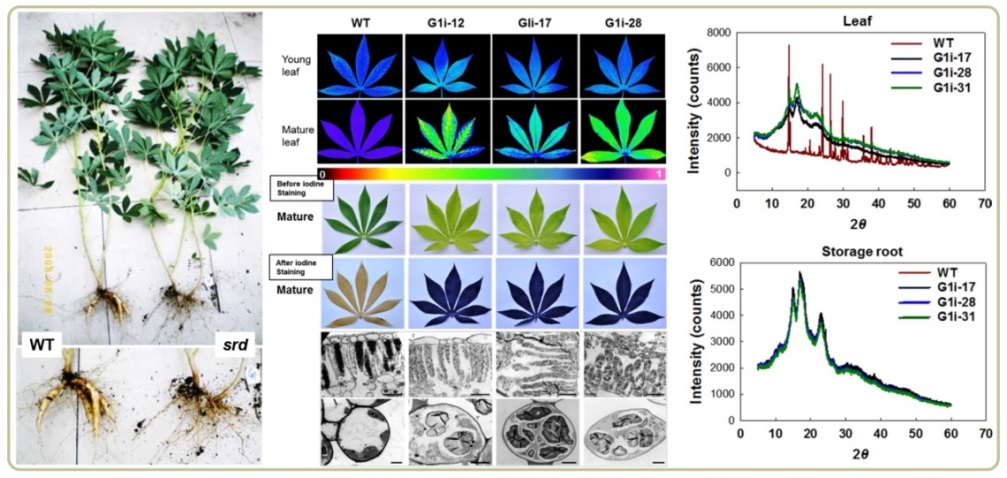As the world's third-largest food crop, cassava accumulates large amounts of starch in its storage roots, providing a major source of food energy for nearly 700 million people in tropical and subtropical regions. Better understanding its regulation of starch metabolism can not only increase our knowledge of the source-sink partitioning mechanism but also improve yield in root crops at large.
Using the first cassava T-DNA insertion mutant storage root delay (srd), scientists led by Dr. ZHANG Peng at Shanghai Institute of Plant Physiology and Ecology, Chinese Academy of Sciences, revealed that the α-glucan, water dikinase 1 (GWD1) gene, was the key gene which caused the retarded plant and storage root growth. The srd mutant was identified after screening a cassava T-DNA population of more than 300 lines that were grown under the conditions of greenhouse. After three months of growth using in vitro shoot cultures as planting material, the srd plants showed normal foliage development but lacked storage roots.
Their study showed that the GWD1 is in charge of starch phosphorylation and is essential for transient starch turnover. Repression of the GWD1 expression by RNAi in transgenic cassava resulted in starch excess phenotypes, as evidenced by iodine staining assays of the leaves at the end of the light period. Thus, the transgenic leaves displayed reduced photosynthetic capacity and decreased levels of soluble saccharides. Starches extracted from the leaves showed greatly increased amylose content and type C semi-crystalline structures with increased short chains by X-ray diffraction analysis, a pattern that is similar to cassava storage root starches. The findings indicated that the GWD plays a key role in maintaining transient starch morphogenesis and affects the physicochemical properties of starch.
It is also confirmed that starch degradation in cassava is catalyzed by β-amylase in collaboration with GWD1 function by phosphorylation of starch. The result provides further evidence that GWD1, by keeping photo-assimilation partitioning in a low level from the source to the sink and through starch mobilization in root crops, can function as a regulator in transient starch morphogenesis and storage root growth. Therefore, it sheds light on the transient starch turnover and storage starch accumulation mechanism. Also these germplasms provide new source for leaf utilization.
The work, entitled “Alpha-Glucan, Water Dikinase 1 Affects Starch Metabolism and Storage Root Growth in Cassava (Manihot esculenta Crantz)”, was published in Scientific Reports on August 29,2017. It was conducted in collaboration with Profs. Wilhelm Gruissem and Samuel Zeeman from ETH Zurich. The study was supported by projects from the Chinese Academy of Science, Ministry of Science and Technology, Ministry of Agriculture, National Science Foundation of China, Sino-Swiss Science and Technology Cooperation and National Key laboratory of Plant Molecular Genetics.
Article link: www.nature.com/articles/s41598-017-10594-6

Figure legend: Phenotypic analysis of cassava plants with reduced expression of α-glucan, water dikinase 1 gene.
Author contact:
Dr. ZHANG Peng, Principal Investigator
Institute of Plant Physiology and Ecology
Chinese Academy of Sciences
300 Fenglin Road
Shanghai 200032
Phone: (86) 21- 54924096
Email: zhangpeng@sibs.ac.cn

